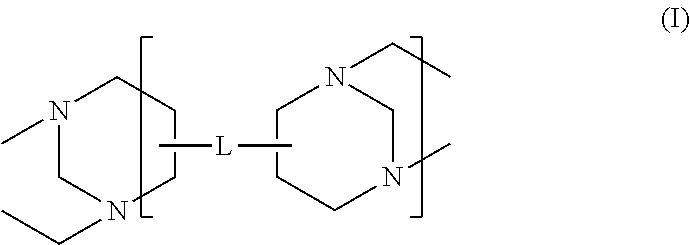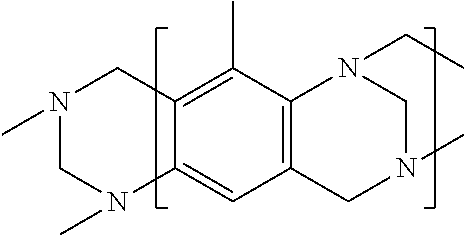High solids polycarboxylate synthesis for cement superplasticizers
- Summary
- Abstract
- Description
- Claims
- Application Information
AI Technical Summary
Benefits of technology
Problems solved by technology
Method used
Image
Examples
example 1
ion of 3,5-diaminobenzoic Acid Dihydrochloride, with Dimethoxymethane in Trifluoroacetic Acid as Represented in Reaction Pathway II
[0076]Reaction Stoichiometry: 1) 3,5-Diaminobenzoic acid dihydrochloride, 99%, 1.50 grams used (6.665 millimole). 2) Dimethoxymethane, 99.9% actual GC purity on COA, 2.03 grams used (26.658 millimole). 3) Trifluoroacetic acid (TFA), 99%, 99.8% actual GC purity on COA, 20 milliliters used.
[0077]3,5-Diaminobenzoic acid dihydrochloride was weighed under dry nitrogen into a 2 ounce glass bottle containing a magnetic stirring bar and TFA was added. The bottle was sealed and magnetically stirred to give a light amber colored solution and thereafter dimethoxymethane was added, the bottle resealed with continued stirring until a bright yellow colored slurry initially formed. After 67.5 hours, the slurry was transferred to a 500 milliliter glass beaker along with 200 milliliters of DI water with continued stirring and pH adjustment from 1 with dilute 5% weight so...
example 2
ion of 3,5-Diaminobenzoic Acid Dihydrochloride, with Paraformaldehyde in Trifluoroacetic Acid as Represented in Reaction Pathway I
[0081]Reaction Stoichiometry: 1) 3,5-diaminobenzoic acid dihydrochloride, 99%, 1.50 grams used (6.665 millimole). 2) Paraformaldehyde, >88%, 0.80 gram used (26.658 millimole). 3) Trifluoroacetic acid (TFA), 99.8% actual GC purity on COA, 20 milliliters used. 3,5-Diaminobenzoic acid dihydrochloride and paraformaldehyde were weighed under dry nitrogen into a 2 ounce glass bottle along with a magnetic stirring bar and TFA was added with magnetic stirring. The bottle was sealed and magnetically stirred to give a yellow colored slurry. After 67 hours, the slurry was transferred to a 500 milliliter glass beaker along with 200 milliliters of DI water with continued stirring and pH adjustment from 1 with dilute 5% weight sodium hydroxide solution to 7. At pH 7, the bright orange powder went into solution with only a slight haziness. The pH was then adjusted to 3,...
example 3
ion of 2,4-diaminophenol Dihydrochloride with Dimethoxymethane in Trifluoroacetic Acid as Represented in Reaction Pathway VI
[0086]Reaction Stoichiometry: 1) 2,4-Diaminophenol dihydrochloride, 98%, 1.50 grams used (7.612 millimole). 2) Dimethoxymethane, 99.9% actual GC purity on COA, 2.32 grams used (30.45 millimole). 3) Trifluoroacetic acid (TFA), 99.8% actual GC purity on COA, 20 milliliters used.
[0087]2,4-diaminophenol dihydrochloride was weighed under dry nitrogen into a 2 ounce glass bottle containing a magnetic stirring bar and TFA was added. The bottle was sealed and magnetically stirred to give a gray colored slurry and thereafter dimethoxymethane was added, the bottle resealed with continued stirring until a hazy dark amber colored solution formed. After 67.5 hours, the hazy solution was transferred to a 500 milliliter glass beaker along with 200 milliliters of DI water with continued stirring and pH adjustment from 1 with dilute 5% weight sodium hydroxide solution to 7. At ...
PUM
 Login to View More
Login to View More Abstract
Description
Claims
Application Information
 Login to View More
Login to View More - R&D
- Intellectual Property
- Life Sciences
- Materials
- Tech Scout
- Unparalleled Data Quality
- Higher Quality Content
- 60% Fewer Hallucinations
Browse by: Latest US Patents, China's latest patents, Technical Efficacy Thesaurus, Application Domain, Technology Topic, Popular Technical Reports.
© 2025 PatSnap. All rights reserved.Legal|Privacy policy|Modern Slavery Act Transparency Statement|Sitemap|About US| Contact US: help@patsnap.com



